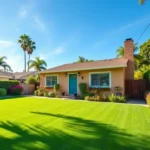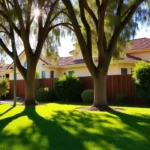Water is a precious resource, and with increasing concerns about drought and conservation, homeowners are looking for ways to maintain stunning landscapes while reducing water usage. The good news? You don’t have to sacrifice beauty for sustainability. With the right approach to water-wise landscaping, you can create a vibrant and eco-friendly yard that thrives with minimal water waste. Here’s how.
1. Choose Drought-Tolerant Plants
One of the easiest ways to reduce water consumption is by selecting plants that naturally require less moisture. Native plants and drought-resistant species thrive in local climates, adapting to weather conditions without the need for excessive watering. Consider these options:
Succulents & Cacti – Low-maintenance and visually striking.
Lavender & Sage – Hardy, fragrant, and pollinator-friendly.
Ornamental Grasses – Provide texture and movement while being highly drought-resistant.
California Poppy & Yarrow – Colorful native flowers that flourish with little water.
2. Implement Efficient Irrigation Systems
A well-planned irrigation system can make a huge difference in water conservation. Drip irrigation is one of the best options, delivering water directly to the roots with minimal evaporation or runoff. Other water-saving irrigation tips include:
Watering Early or Late in the Day – Avoid mid-day evaporation by watering in the early morning or evening.
Installing Smart Controllers – Use weather-based irrigation controllers to adjust watering schedules automatically.
Grouping Plants by Water Needs – Place plants with similar moisture requirements together to optimize watering efficiency.
3. Use Mulch to Retain Moisture
Mulch is a simple yet powerful tool for conserving water. A layer of organic mulch around plants and garden beds helps to:
Reduce evaporation by keeping soil cool and moist.
Suppress weeds that compete for water.
Improve soil health by breaking down over time.
Prevent soil erosion from wind and rain. Apply 2-4 inches of mulch around trees, shrubs, and flower beds to maximize benefits.
4. Incorporate Hardscaping Features
Hardscaping elements like patios, walkways, and decorative stone areas reduce the need for water-dependent plants while enhancing the aesthetic appeal of your yard. Some great options include:
Paver or gravel pathways – Low-maintenance and stylish.
Rock gardens – A beautiful alternative to traditional flower beds.
Permeable paving – Allows water to absorb into the ground instead of running off. Strategically placed hardscape features can balance your landscape while reducing overall water demand.
5. Replace Traditional Lawns with Artificial Turf or Ground Covers
Traditional grass lawns require frequent watering, mowing, and fertilizing. A more water-efficient alternative is artificial turf, which offers a lush, green appearance without the high maintenance. For a natural option, consider drought-tolerant ground covers like:
Creeping Thyme – Aromatic and attracts pollinators.
Dymondia – Hardy, low-growing, and thrives in full sun.
Sedum – A succulent variety that spreads beautifully with minimal water needs. Replacing even a portion of your lawn can significantly cut down on water use.
6. Collect and Reuse Rainwater
Rainwater harvesting is an excellent way to supplement your irrigation needs without increasing water bills. Simple methods include:
Rain Barrels – Collect roof runoff for later use in gardens and flower beds.
Permeable Surfaces – Allow rainwater to soak into the ground rather than running off.
Bioswales – Channels designed to capture and direct rainwater for landscape use. Even in dry climates, occasional rainfall can be captured and stored to keep your plants hydrated naturally.
7. Maintain Healthy Soil
Healthy soil retains moisture better, reducing the need for frequent watering. Improve your soil’s water-holding capacity by:
Adding organic matter like compost or aged manure.
Aerating compacted soil to allow better water absorption.
Avoiding chemical fertilizers that can disrupt soil structure. Healthy soil not only supports plant growth but also reduces runoff and erosion.
Conclusion: A Beautiful Yard with Less Water
Water-wise landscaping is not just about conservation—it’s about creating a sustainable, low-maintenance, and visually stunning outdoor space. By selecting the right plants, optimizing irrigation, using mulch, and incorporating hardscaping, you can enjoy a lush landscape while significantly reducing water usage.
Ready to make your yard more water-efficient? LFR Landscape specializes in drought-friendly landscaping solutions that keep your outdoor space beautiful and eco-friendly. Contact us today to start transforming your yard!




